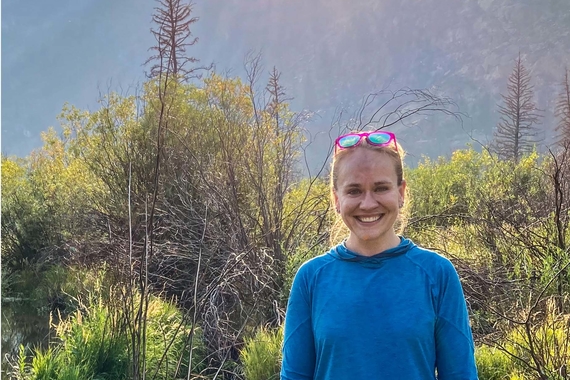Three Students Take on Several Hundred Trees
Pictured L to R Suzanne Scotty, Cait Bell, and Madison Pettersen. Photo by Austin Miller, CLAgency student
“If [students] want jobs when [they] graduate, it's helpful to have some kind of meaningful experience,” says Associate Professor Kurt Kipfmueller, who has taken this approach as a teacher and as a researcher. Geography undergraduates Suzanne Scotty, Cait Bell, and Madison Pettersen are reaping the benefits of his inclusive philosophy.
Since November, the three have been working part-time in Kipfmueller’s lab, gaining experience using everyday software like Excel and in more nuanced projects like cataloging field samples.
Currently, this group of researchers works with vegetation data to analyze Minnesota’s forest structure.
In The Lab
Research and readiness collide in a dendrochronology lab on the fifth floor of the Social Sciences Building. There, Bell, Scotty, and Pettersen complete a variety of tasks using tree ring samples to analyze what happened throughout a forest’s lifetime, including fire history and invasive species.
When studying a forest, it’s important to understand that the earth has a natural fire regime, and lightning is a leading cause. However, Kipfmueller explains, according to the records of Minnesota’s fire history, “there is not a high enough rate of lightning to match the rate of fire [in this forest area] between 1750 and 1900.”
One theory the team is exploring suggests that, Ojibwe people burned landscapes possibly to improve blueberry harvests. Although they don’t have conclusive proof yet, they posit that the Ojibwe would light these fires every so often, and the routine undoubtedly impacted the environment.
As part of this project and others, Bell, Scotty, and Petterson might archive tree cores, measure ring widths of cores, conduct skeleton plotting (a form of dating materials), and use other professional-level lab equipment. In addition to the lab work, Pettersen mentions that “getting to interact with faculty members and people within the department is definitely beneficial.”
The Working Student
Kipfmueller has given Bell, Scotty, and Petterson a lot of independence in the lab. As they bounce around to several different projects, the students get their hands on all parts of the research with Kipfmueller serving as their mentor to the students
He lets them know: “You have to figure out how you do it. Yeah, I'll give you feedback. But I want you to work with it and figure it out.” He adds, “They’re employees, in a sense, yet they’re still students. There are tasks I need done a certain way, but there are also tasks that have a bit of leeway that they can actually use their creativity and learn.”
By finding answers on their own, the students develop their problem-solving skills and digital literacy. However, they often “help each other out if [they] have any doubts. It’s a very collaborative effort,” says Petterson.
The lab work integrates schoolwork for a more holistic education. “I’ll learn things in class that I can use here and learn things here that I can use in class,” says Bell.
Currently, they continue looking at Ojibwe fire history along with a tree core analysis from the Idaho Department of Lands.
One of Kipfmueller’s former undergraduate students works as an entomologist for the Idaho Department of Lands. She sent hundreds of tree cores from a forest impacted by an invasive insect: balsam woolly adelgid. The students collected the data from these cores and analyzed their rings in search of an impact on growth rate. By measuring the width of each ring, a researcher can determine the amount of growth a tree produced in a year. They are attempting to discover how to detect an insect invasion based on this ring analysis. “They also archived my entire collection of fire-scarred materials, which is about 500 samples,” mentions Kipfmueller.
Future Endeavors
“The research matters to us. We’re uncovering history from 100 plus years ago,” says Scotty, “not only for us, but for other communities. [Through] the fire history work through the Boundary Waters—we're finding out a lot about the history of the Ojibwe who used to live there and their practices, like where they were going and why.” The importance of this research and the pieces of history that would be otherwise forgotten resonate with the students. Cultural heritage is valuable, and geographical research plays a critical role in supporting that knowledge.
Since their work is currently conducted on campus, the team of students looks forward to an opportunity to participate in field research, such as collecting tree samples themselves.
“I’m trying to keep them around because they’re doing really good work,” Kipfmueller says, so he is currently writing grant proposals to fund the undergraduates’ fieldwork.
“Working here opened my eyes to a whole different side of geography that I just wouldn’t have considered before,” adds Bell. This research is powerful because it reveals the infinite applications of geography. Through studying natural history, these three students are building bright futures.
This story was written by an undergraduate student in CLA.



